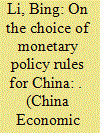| Srl | Item |
| 1 |
ID:
109340


|
|
|
|
|
| Publication |
2011.
|
| Summary/Abstract |
This article employed a standard LCC to conduct economic analysis of upgrading the aging residential buildings in China. According to the current situation, an interest rate of 6%, an inflation rate of 3%, an increase rate of annual energy savings of 2% and an increase rate of electricity price of 2% were assumed in the method. The results indicated that only relying on gradually increasing electricity price and governments' subsidies was not enough. After detailed analysis of the energy saving measures and the distribution of all benefits from building energy retrofit, it was found that actually only 1/3 of original cost was spent only for energy savings, the second 1/3 for both energy savings and good façade appearance and occupants should share the last 1/3 because even if without energy retrofit, they would have to pay the part too. The corresponding results proved that the first 1/3 of investment cost could be drawn back within the residue life cycle, and so the investment could be accepted in a sheer market economy. In the end, a model about distribution of investment cost of and benefits was proposed to adapt the market economy to overcome the financial problems in China.
|
|
|
|
|
|
|
|
|
|
|
|
|
|
|
|
| 2 |
ID:
159054


|
|
|
|
|
| Summary/Abstract |
Motivated by the institutional features of China's monetary policy, this paper aims at identifying the most data favored monetary policy rule for China within a dynamic stochastic general equilibrium (DSGE) model framework. In a canonical New-Keynesian DSGE model, we carry out a positive analysis by employing Bayesian methods to estimate three main categories of monetary policy rules, namely a Taylor-type interest rate rule, a money growth rule and an expanded Taylor rule with money. Based on China's quarterly data from 1996Q2 to 2015Q4, our estimation shows that the expanded Taylor rule obtains the best empirical fit to the data. Moreover, impulse responses and forecast error variance decompositions demonstrate that monetary policy rules with or without money provide very different implications for the policy behavior. Our results ultimately suggest that money has so far been more closely targeted than nominal interest rate and still plays an important role as a monetary policy target in China. Furthermore, a conventional Taylor-type interest rate rule is not good enough yet to describe China's monetary policy behavior.
|
|
|
|
|
|
|
|
|
|
|
|
|
|
|
|